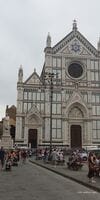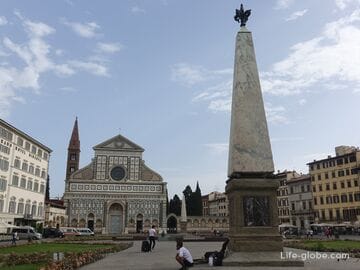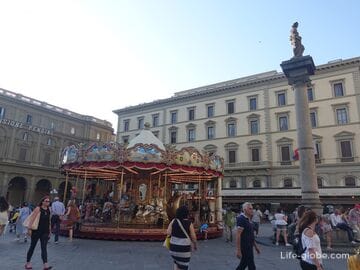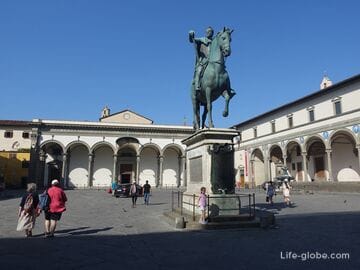Santa Croce Square, translated from Italian: Piazza di Santa Croce (Piazza della Santa Croce) is one of the main squares in the historical center of Florence, where palaces and the basilica complex of the same name are concentrated, there is a fountain and a monument to Dante.
The history of the formation of the square originates from the Franciscans, who arrived in Florence in 1226-1228 and chose an isolated area near the future square for their settlement and the construction of the shrine.
The square itself was born about a century later, in order to accommodate all the believers who came to listen to the sermons of the monks from the majestic church of Santa Croce, from which the square got its name.
Due to the fact that the square is large and of a regular rectangular shape, during the Renaissance it was the site of horse races and jousting tournaments, festivals, shows and popular competitions such as costumed football, which is still held every June. The famous game took place here on February 17, 1530, during the siege of Florence by the Imperial wars: so that the enemies could see them, and as a sign of contempt, the players were dressed in livery. The square is still used for various events, celebrations and concerts.
Today, Santa Croce Square is pedestrian; it is surrounded by bright historical buildings, including palaces, the basilica of the same name with monasteries, chapels and tombs.
In the buildings around the square there are shops, cafes and restaurants with outdoor tables, there are also accommodation facilities (hotels, apartments)

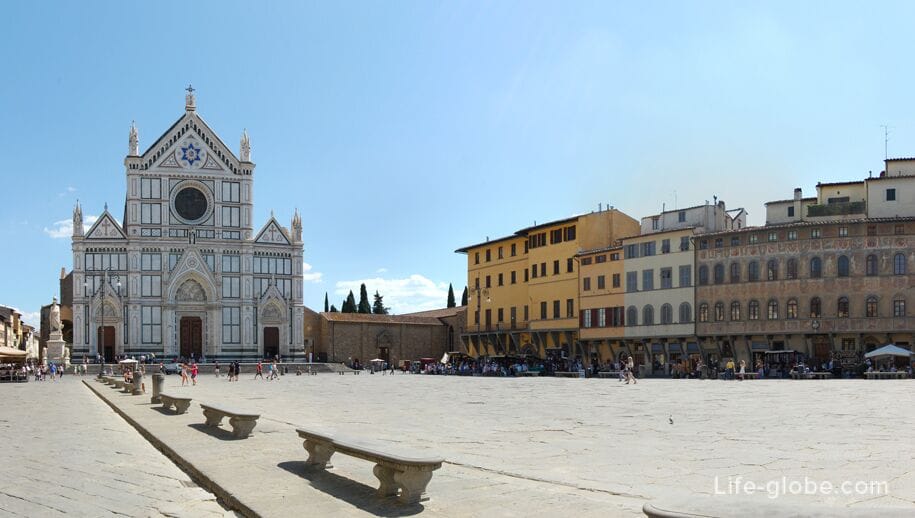
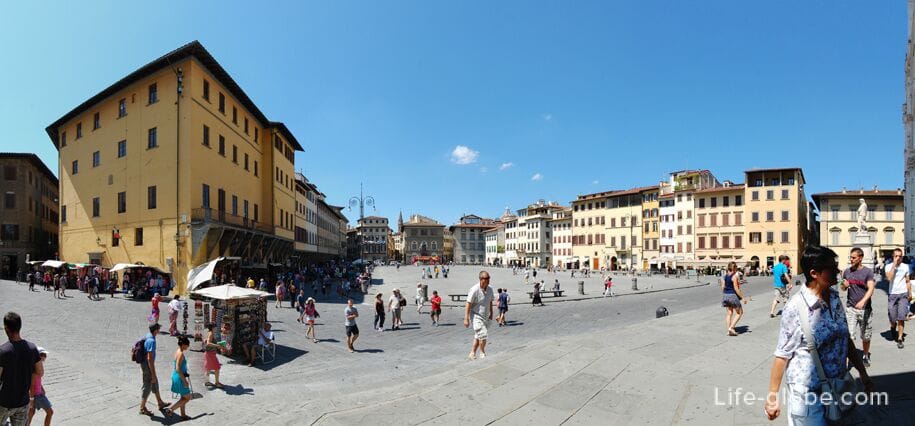
On the east side of Santa Croce Square is its dominant - the Basilica of Santa Croce or the Holy Cross (Basilica di Santa Croce) - one of the oldest religious buildings in Florence and one of the largest Franciscan churches in the world, famous for its works of art and burials.
Santa Croce is a monumental complex, which is one of the most popular attractions in Florence.
The complex includes the church itself with chapels, frescoes by famous artists, including Giotto, sculptures by Benedetto da Maiano, Desiderio da Settignano and Canova, numerous tombs of great people of Italy, including Michelangelo, Galileo, Foscolo and Machiavelli, as well as monasteries with a museum, sacristy, crypt, chapels of Pazzi and Medici.
Thanks to the abundance of tombs, the basilica is called the "Florentine Pantheon", and thanks to the halls of fame and memory - the "Temple of Italian Glory" (Tempio dell'ITALE Glorie). More about the Santa Croce complex…
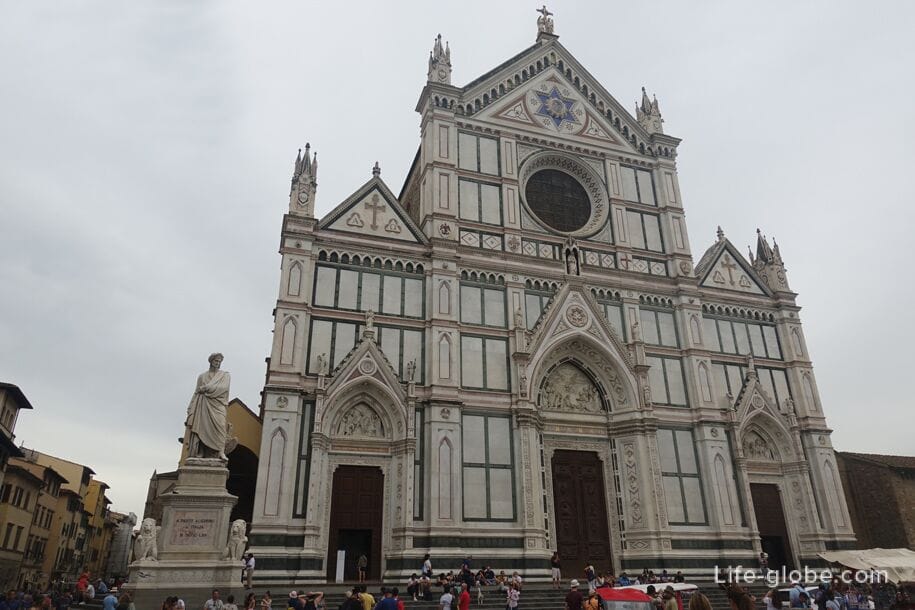
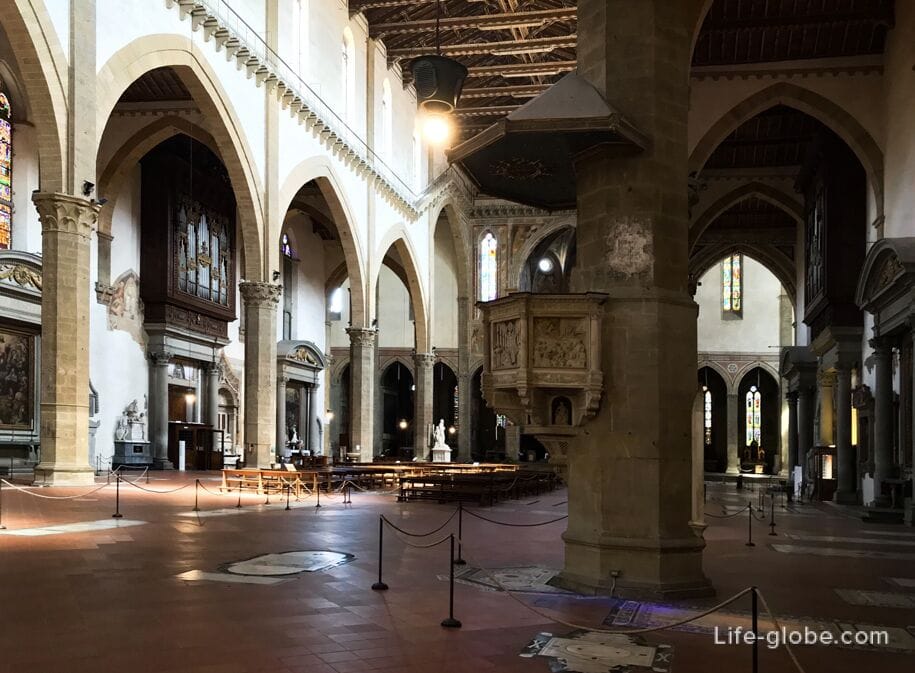
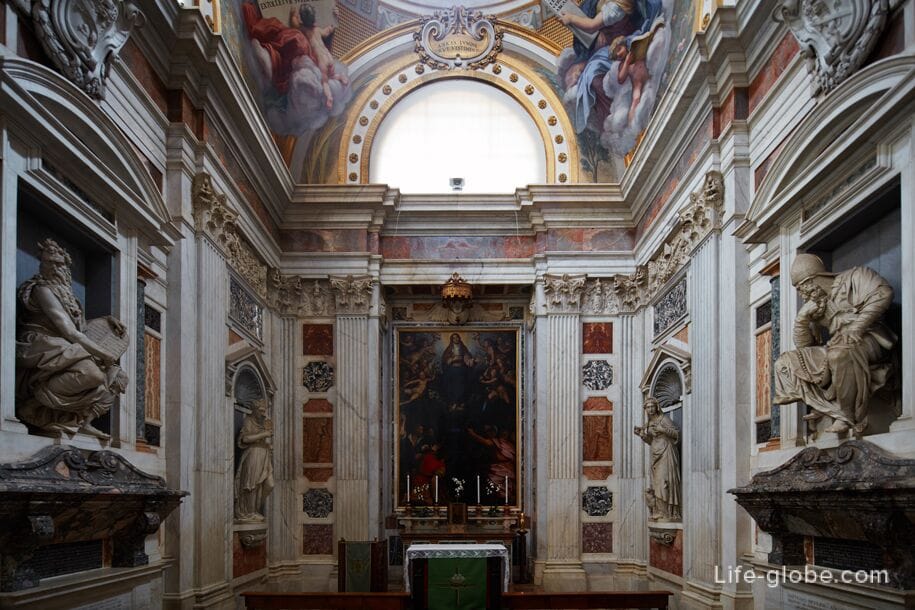
Near the main entrance to the basilica there is a monumental marble monument to Dante Alighieri (Monumento a Dante Alighieri).
The monument was created in 1865 in honor of the 600th anniversary of Dante's birth, which coincided with the first year of Florence as the capital. This is the work of the Italian sculptor Enrico Pazzi.
The statue was originally placed in the center of the square, but after the 1966 flood it was moved to its current location.
The sculpture in white Carrara marble depicts Dante Alighieri standing erect and with a stern expression on his face, with his head crowned with laurel. Dante holds the Divine Comedy in his right hand. Nearby there is a sculpture of an eagle with half-lowered wings.
On the high pedestal of the monument there is an inscription: "A DANTE ALIGHIERI L'ITALIA M·DCCC·LXV". There are also sculptures of lions, and below – bas-reliefs depicting the coats of arms of forty major Italian cities.
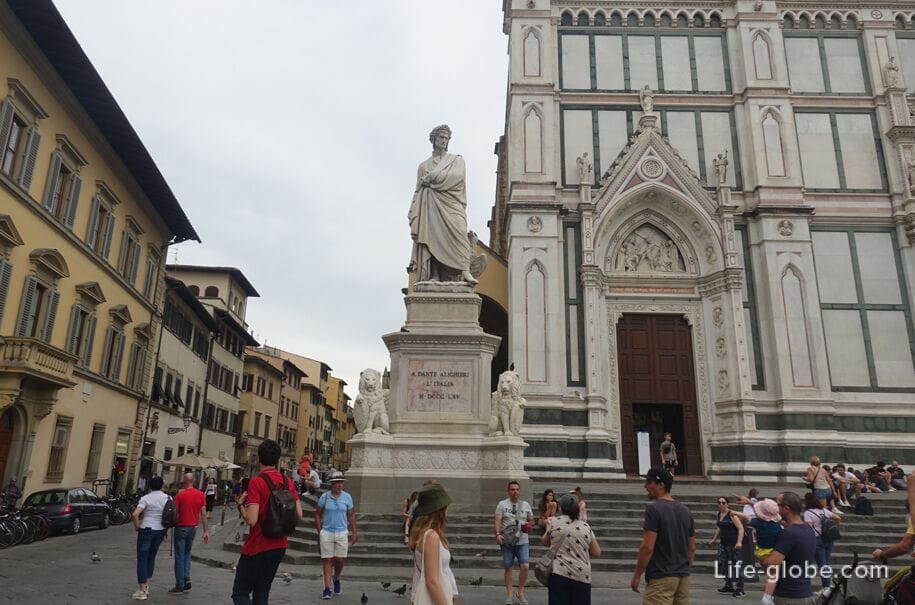
On the opposite side of Santa Croce Square, there is a Baroque fountain, which is a nineteenth-century reconstruction by the Italian architect Giuseppe Manetti (1816), originally created by the Italian Pietro Maria Bardi in 1673.
The structure of the fountain consists of an octagonal base of brecciated marble, on two sides of which there are two bowls in the shape of shells over which two lion heads are placed, from which water flows from the fountain pool, which, in turn, is fed from another small upper pool, into which water jets fall from the top of the structure, topped with a model three-lobed Florentine lily. The top of the fountain is decorated with a grand ducal crown.
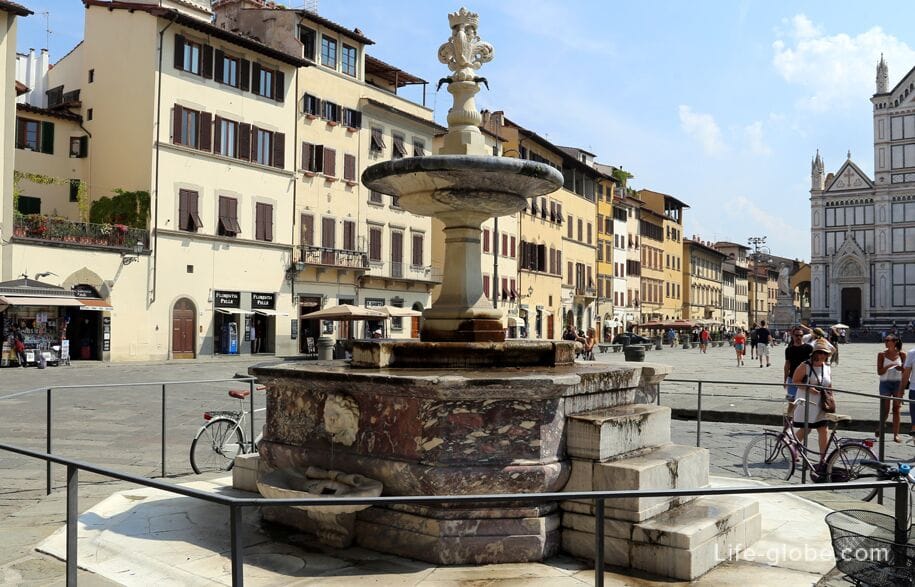
The southern and western sides of Santa Croce Square are framed by former noble palaces.
These palaces are characterized by protruding planes, beautiful forms, which are, among other things, the results of the transformations of the 19th century, elegant balconies and some decorations.
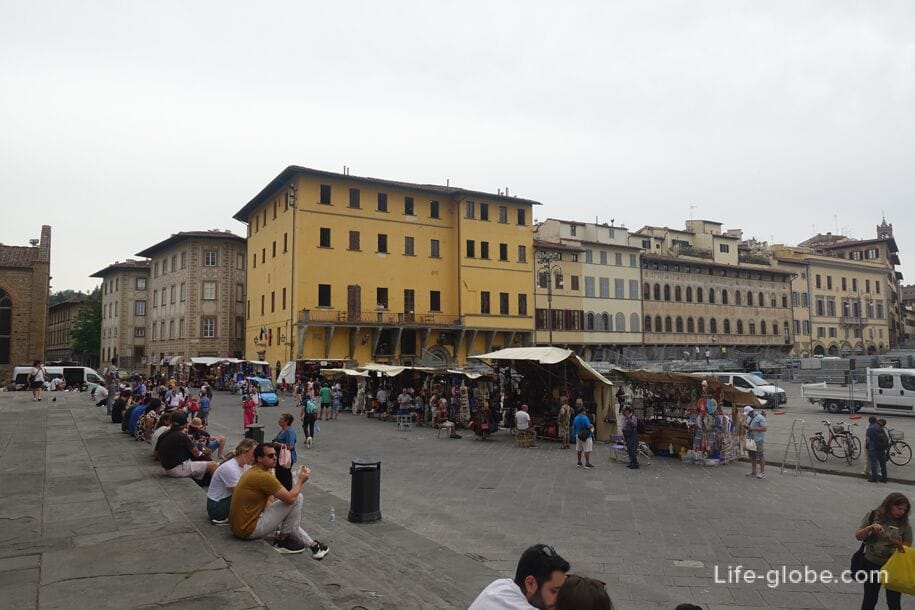

In the southern part of the square, the Antella Palace (Palazzo dell'antella, Palazzo del Antella) is particularly noteworthy, which appeared due to the unification of several houses and is now one of the most prominent elements of the Santa Croce Square.
The first significant expansion of the palace dates back to the middle of the sixteenth century, when the building belonging to Del Barbigi was raised by one floor, and the wooden ledges were replaced by stone ones, which are still visible today. At the beginning of the seventeenth century, the building passed to Senator Niccolo Dell'Antella, who bought a neighboring house and gave them a single look, completely painting the facade with frescoes. The decoration on the theme of Virtue and Divinity was completed in a few weeks in 1619 by a team of thirteen young artists led by the Italian artist Giovanni da San Giovanni.
Today this building has a beautiful complex facade decorated with frescoes depicting allegorical figures, cherubs, foliage, flowers and arabesques, which are placed around and above the bust of Cosimo II de' Medici. Especially interesting, on the fourth tile on the left, is the fresco of the sleeping Cupid by Caravaggio.
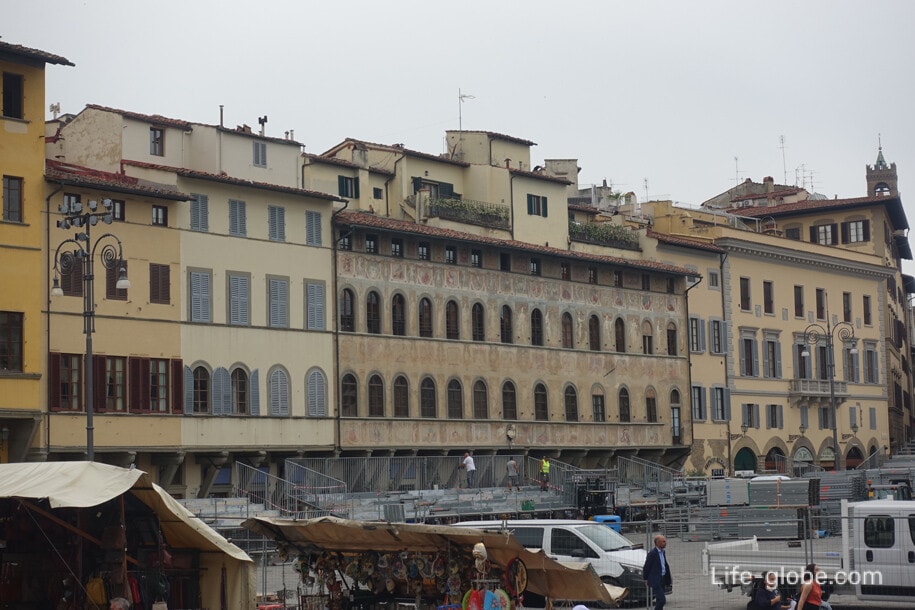
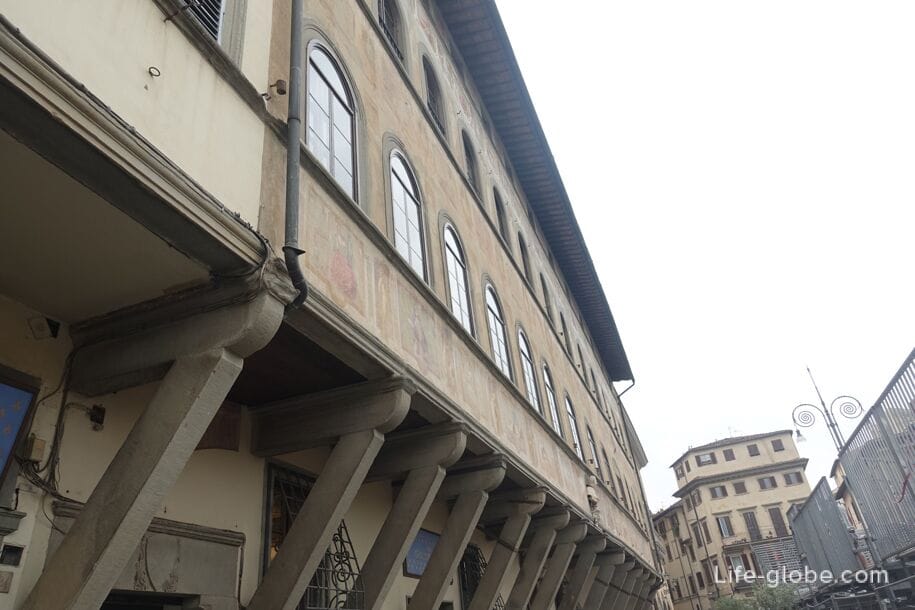
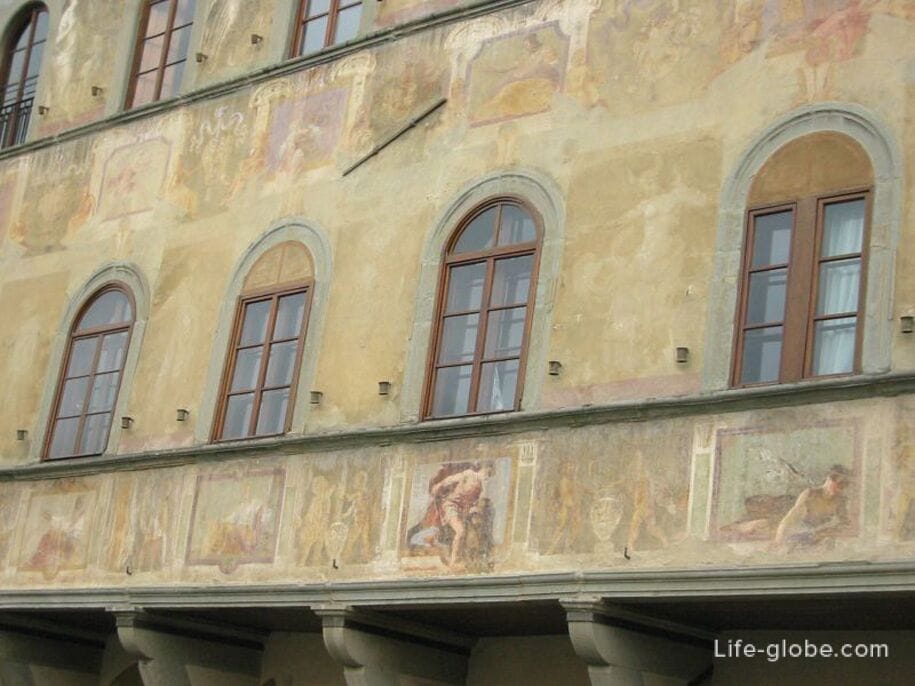
Fresco of the sleeping Cupid

Inside the Antella Palace, an atrium with wooden beams stands out, from which a staircase leads to the upper floors, as well as a small courtyard with low arches (partially walled up). Two rooms on the ground floor are decorated with frescoes of the seventeenth century, which architecturally complement the frescoes on the facade.
The garden of the palace still retains the appearance of a medieval garden. Once in the garden there was a fountain with a marble bowl and a statue of a Little boy with a horn, commissioned by Giambologna Del Barbigia, but executed by Pietro Tacca. The statue was lost, then Papa Hennessy found it, and now it is dismembered between the Hermitage in St. Petersburg and the Victoria and Albert Museum in London.
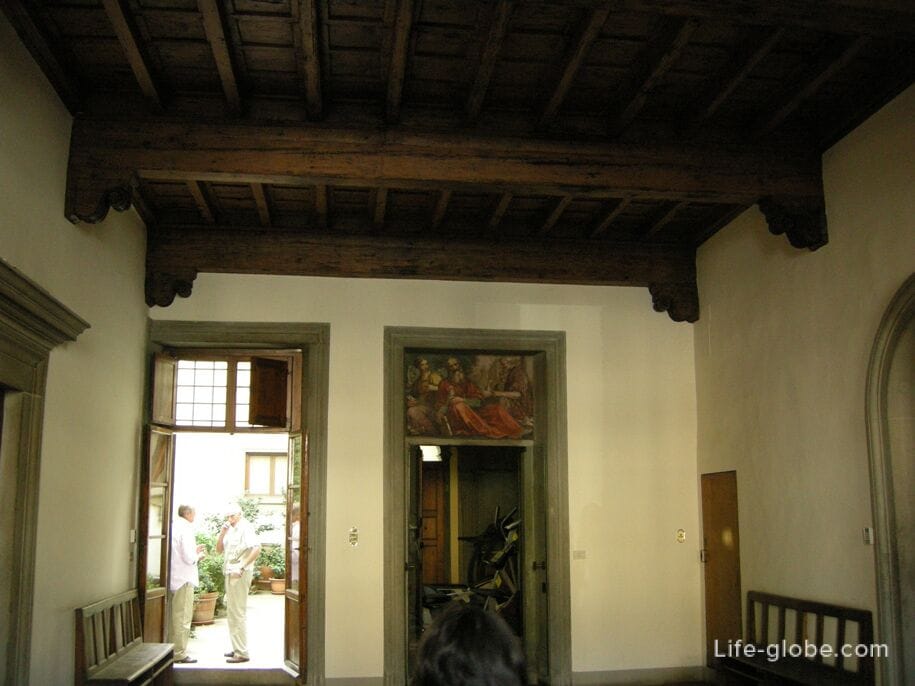

On the western side of Santa Croce Square, the Cocchi-Serristori Palace stands out, having the shape of an irregular cube and with an elegant facade.
The current palace is the result of transformations over several centuries. The pillars of the base part date back to the fourteenth century (at that time the building belonged to the Peruzzi family), as evidenced by the uneven rustic covering of hewn stone and coats of arms inserted into the masonry, which, although erased, have a simple shield shape characteristic of fourteenth-century samples. On this ancient foundation stands a new building, which dates from the period between 1485 and 1490, and was built under Antonio Cocchi (since 1463 the building was acquired by the Cocchi family), a Florentine lawyer very close to the Medici. The original project belongs to Giuliano da Sangallo, the trusted architect of Lorenzo the Magnificent.
Then the palace changed owners (Pucci, Serristori, Caselli) until, finally, it passed to Agostini Venerosi della Seta of Pisa by inheritance of Maddalena Serristori, daughter of Luigi Serristori.
Now the building has side projections, and its main facade, facing Santa Croce Square, is notable for a balcony, original window openings and some discreet decorations.
The interiors of the palace underwent interventions between 1790 and 1795, designed by engineer Gaetano Berchigli. Inside the building there is a neoclassical staircase and frescoes attributed to Atanasio Bimbacci. Also in the building is a small chapel, built in 1717 with frescoes by Dionisio Predellini.
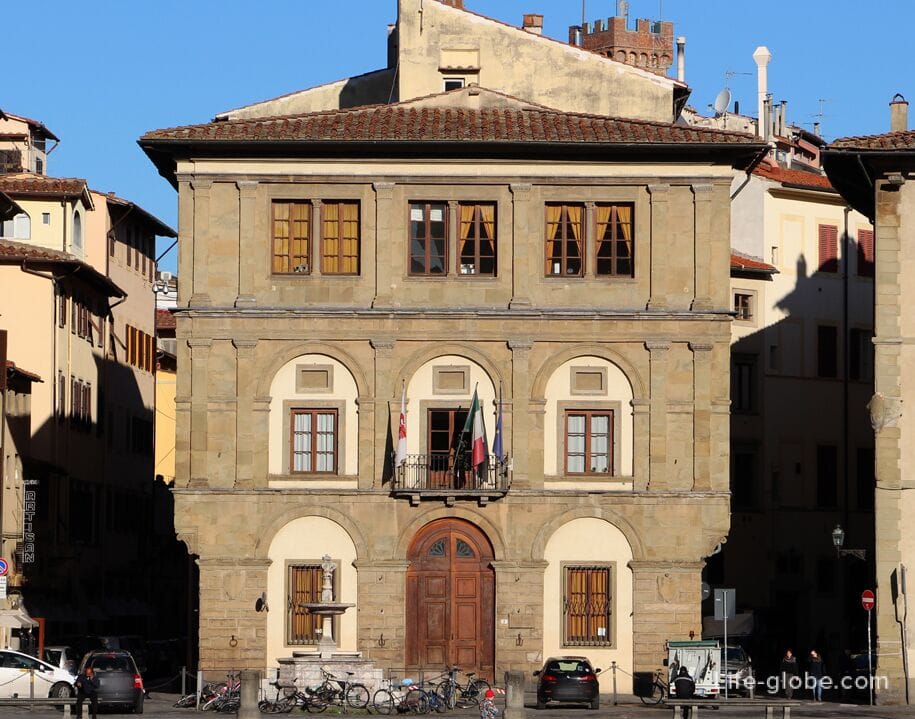
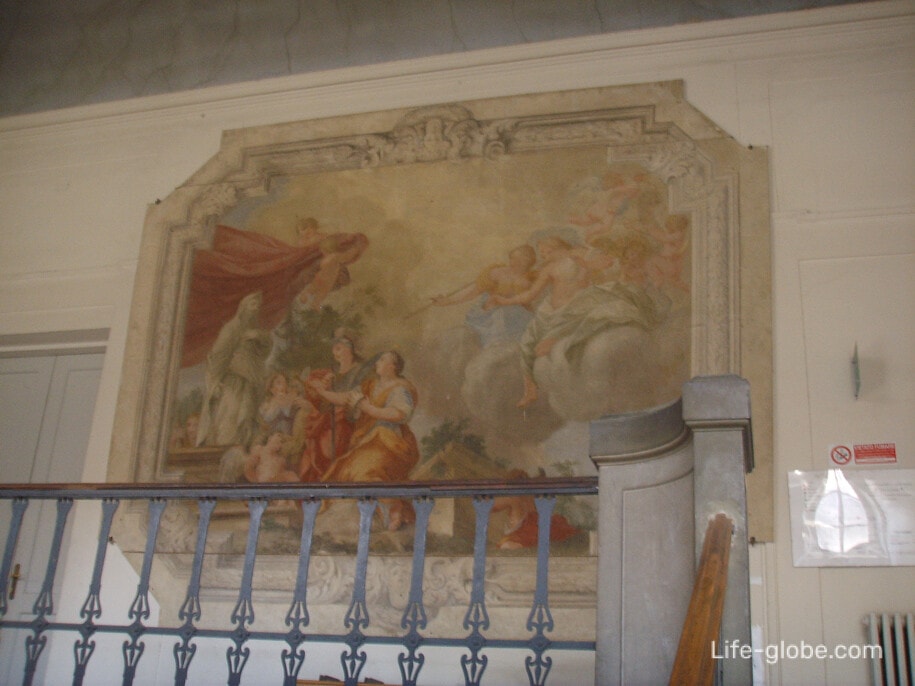
Outside the Cocchi Serristori Palace, in the resega of the wall on via dell'anguillara, there is "a real relic of the medieval city, that is, the loop of the ancient city gate, opened in the second tier of the walls and possibly bearing the name of Porta a San Simone" (Bargellini Guarnieri). Here, on the wall of the building, you can see an ancient erased coat of arms.
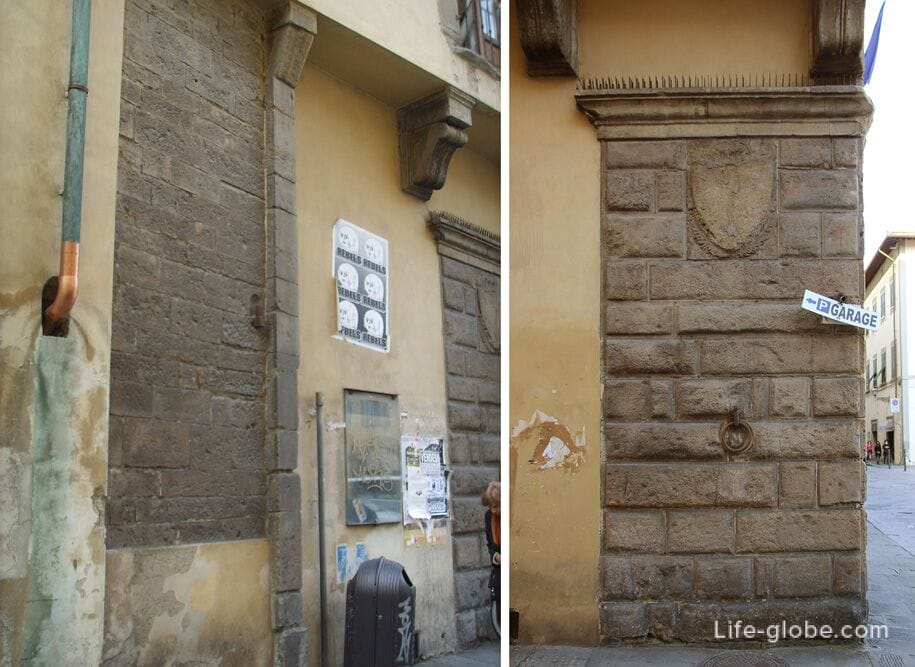
The northern side of Santa Croce Square is occupied by narrower and less important buildings originally of medieval origin.
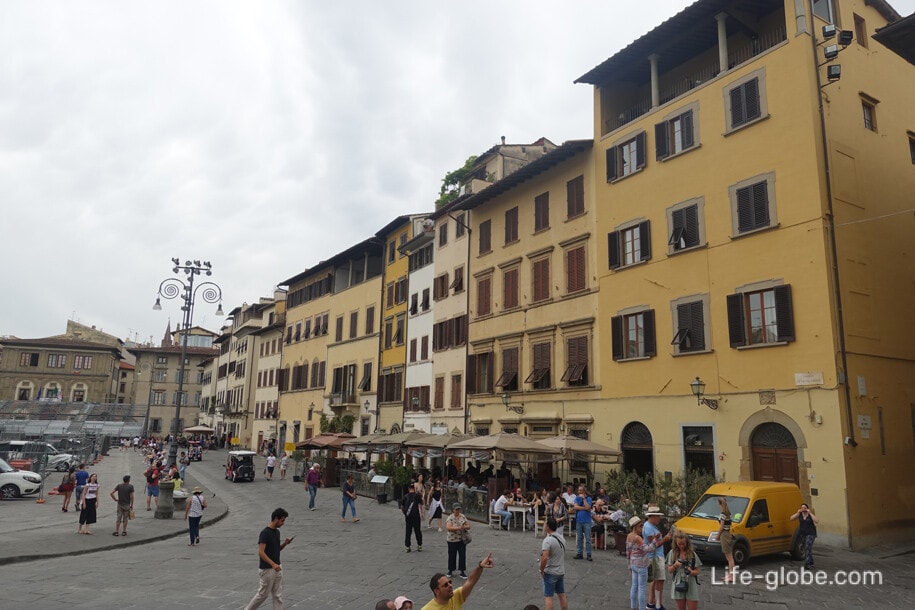
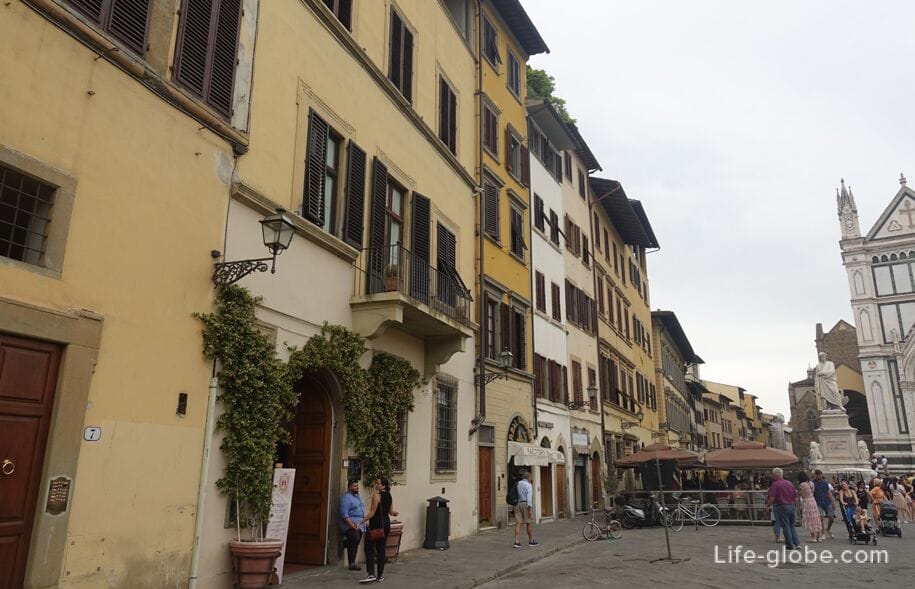
Next to Santa Croce Square, to the right of the basilica, the National Central Library of Florence is notable, which is the largest in Italy and one of the most important in Europe. It is one of the two central libraries of the country, along with the National Central Library of Rome
The library was founded in 1714, when the scientist Antonio Magliabeci bequeathed his collection of books, numbering about 30,000 volumes, to the city of Florence. Since 1870, the library has collected copies of all Italian publications. Since 1935, these collections have been housed in a building designed by the outstanding Italian architects Cesare Bazzani and V. Mazzei, and before that the collections of books were located in various halls belonging to the Uffizi Gallery of Florence.
Library website: bncf.firenze.sbn.it.
There is a rotunda near the Santa Croce Square near the library building.
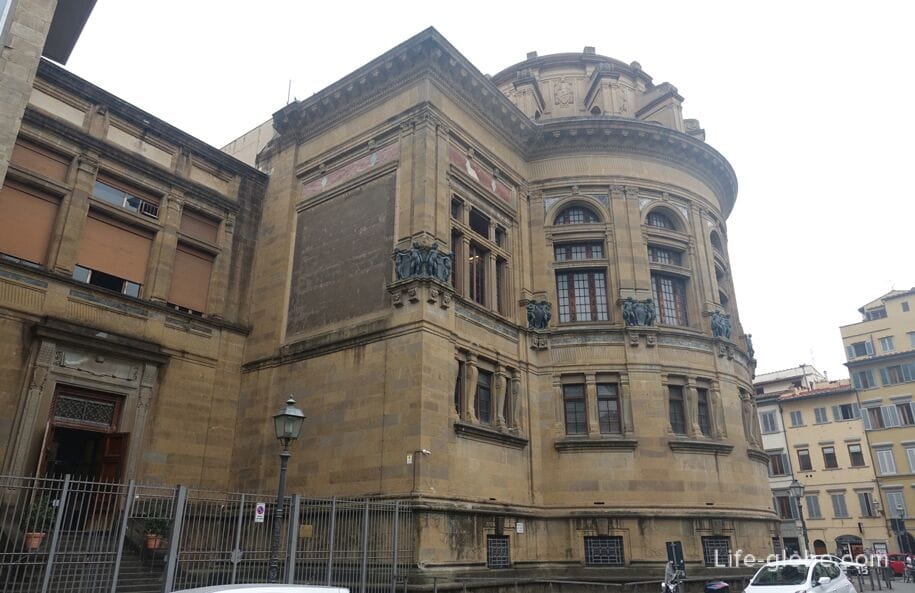
With one facade with arches, perhaps the most striking, the library overlooks the Arno River.

Where to stay in Santa Croce Square
On and near Santa Croce Square, which means in the historical part of Florence, which is convenient for walking and exploring the sights of the city, you can stop:
La Croce d'Oro Santa Croce Suite Apartments
All accommodation facilities in Florence (hotels, apartments, guest houses, etc.), including those in the historic city center, near Piazza Santa Croce and more remotely from those, can view and book here
Practical information
Santa Croce Square is open to the public 24 hours a day.
Santa Croce Square is located in the historic part of Florence, 400 meters from the famous Bargello Palace Museum.
Coordinates of Santa Croce Square: 43°46'07.9"N 11°15'41.3"E (43.768850, 11.261481).




